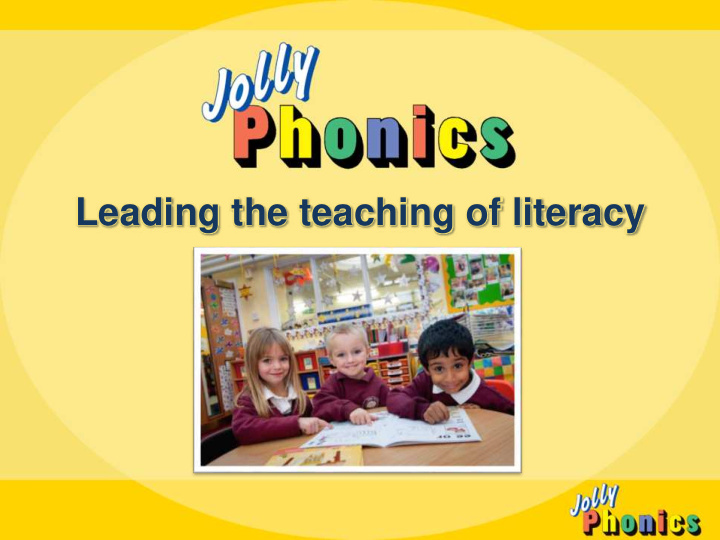



Leading the teaching of literacy
Research The Jolly Phonics’ children’s reading skills were 11 months above the level expected for their age. We found that the boys did as well as the girls. In the Jolly Phonics group the ‘tail’ of low achievement in writing was simply abolished. 2
The 5 Basic Skills The 5 basic skills of Jolly Phonics are: 1. Learning the letter sounds 2. Learning letter formation 3. Blending 4. Identifying sounds in words 5. Tricky words 3
Letter Sounds Children learn in a fun, multi-sensory way using stories and actions. Learning the action for the /s/ sound: Weave your hand like a snake, making an ‘s’ shape, saying sssssssss. 1. Learning the letter sounds 4
Letter Sounds 1. Learning the letter sounds 5
Digraphs Digraphs are two letters that make one sound. 1. Learning the letter sounds 6
Alternative Spellings The alternative spellings of the vowel sounds: Introduced as: Taught later as: (play) (flame) (rain) (feet) (leaf) (these) (snow) (bone) (boat) 1. Learning the letter sounds 7
Blending Skills Blending skills are essential for reading. They can be taught right from the start. 3. Blending 8
Blending Words The number of regular words for blending grows with each new letter sound: Jolly Phonics Word Book Word Boxes 3. Blending 9
Blending Activities Blending activities can be fun and multi-sensory: • Random letters c a s • ‘Miming’ words p e • Read and See books t i n 3. Blending 10
Blending Harder Words Regular practice is the key to blending words with digraphs and consonant blends: Digraphs Word Boxes 3. Blending 11
Phonological Awareness Phonological awareness can be encouraged from the very first lesson: 4. Identifying sounds in words 12
Hearing the Sounds Lots of practice is needed before children can identify all the sounds in words: • Sounding out words • Word families • Removing the first sound • Chopping game 4. Identifying sounds in words 13
Dictation Dictation practice prepares the children for independent writing: • Letter sounds • Simple CVC words • Regular words with consonant blends and digraphs • Phrases and sentences • Capital letters 4. Identifying sounds in words 14
Simple Dictation A sample of early dictation by a five-year-old using Jolly Phonics. 4. Identifying sounds in words 15
Independent Writing For children to write independently they need to know: • The 42 letter sounds • How to hear the sounds in words • One way of writing the letter sounds • What they want to say 4. Identifying sounds in words 16
Independent Writing Independent writing towards the end of the first year: 4. Identifying sounds in words 17
Tricky Words To read tricky words well, the children need to: • Work out the ‘tricky’ bits • Have regular flashcard practice 5. Tricky words 18
Tricky Words To write tricky words well, the children need to learn the following techniques: • Look, copy, cover, write and check • Say it as it sounds • Mnemonics: ‘ o u l ucky d uck!’ • Word families 5. Tricky words 19
Tricky Words ‘Look, copy, cover, write and check’ is a good way to learn how to write tricky words. (Click image to play animation) 5. Tricky words 20
Recommend
More recommend